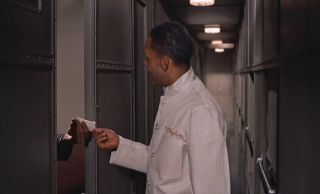The MacGuffin: News and Comment (09/Aug/2008)
(c) Ken Mogg (2008)
August 9
Last time, referring to an observation about Rear Window in Yves Lavandier's book 'Writing Drama', I described how Hitchcock 'took the curse off' a particular shot (of Thorwald leaving his apartment to come and confront Jeff) by distracting us with the thought, 'Oh not again! Jeff always misses seeing what is important!' This time, I want to talk about North by Northwest (1959) and an example of Hitchcock's distracting us that Yves Lavandier's book gives during its long schematic analysis (19 pages) of that film's construction. A film must present its protagonist with obstacles, notes Lavandier. Otherwise there's no conflict and no drama - no film. Analysing North by Northwest, he has a section headed 'Justification of the obstacles', and here's what he says (very perceptively): 'The film contains one implausible, or at least highly improbable, element. When Roger (Cary Grant) catches the train for Chicago, he takes one of the several trains that run between New York and the windy city. This just happens to be the one that [the villain] Vandamm (James Mason) is on. [But] the spectator is not too put out by this slight bending of the rules of logic. This is firstly because he easily accepts coincidences that work against the protagonist (unless they come as a diabolus ex machina [arbitrary, unjustified obstacle], which is far from being the case here), and secondly because the moment when we learn that Vandamm is on the train [see frame-capture below] comes as a surprise, smuggled in by the simultaneous revelation that Eve is working for him. As a result we hardly notice it.' (p. 426 - italics mine) Full marks to Lavandier for pointing out this clever use of distraction in North by Northwest. (Incidentally, I'm reminded of another instance of distraction by Hitchcock - namely, when in Saboteur [1942] Barry (Robert Cummings) sets off the sprinkler system in Mrs Van Sutton's house where he's been held prisoner, and we next see him among a crowd of onlookers in the street outside. 'Shouldn't we tell the audience how he got out?', the film's young screenwriter Peter Viertel asked Hitchcock. 'They'll never ask!', Hitchcock replied.) But I do think Lavandier is mistaken in another of his observations about North by Northwest. Under the heading 'Urgency' he writes: The lack of urgency is ... the film's major omission. There is no scene of suspense in which the protagonist has to race against the clock. The suspense is less strong than it would have been if Hitchcock had introduced a time element. There is, let's face it, something a little artificial about North by Northwest. The film is very entertaining, but ...' (p. 427) And here Lavandier names a number of films that he considers generate more tension than Hitchcock's film, among them The Abyss, The Silence of the Lambs, and The Wages of Fear (and Hitchcock's own Psycho). The trouble with this sort of comparison is that it does an injustice, I think, to the actual nature of North by Northwest, which is to be polished and elegant while entertaining and exciting us in a most sophisticated way (which Martin Scorsese underlined recently when he honoured Hitchcock's film in a brilliant pastiche for a Spanish wine company!). Rear Window is another case in point. It does generate a deal of tension but the sophisticated tone is as much the reason for the film's hold on us as anything else (the murder, after all, takes place offscreen). Significantly, among the numerous headings in Lavandier's discussion of North by Northwest, there is no heading 'Tone'. And clearly there should be (as O.B. Hardison long ago suggested in an essay on "Hitchcock's Rhetoric"). More next time.
This material is copyright of Ken Mogg and the Hitchcock Scholars/'MacGuffin' website (home page) and is archived with the permission of the copyright holder. |

